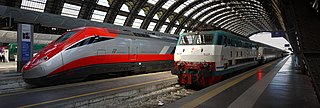
The Italian railway system is one of the most important parts of the infrastructure of Italy, with a total length of 24,227 km (15,054 mi) of which active lines are 16,723 km. The network has recently grown with the construction of the new high-speed rail network. Italy is a member of the International Union of Railways (UIC). The UIC Country Code for Italy is 83.

Ferrovie dello Stato Italiane S.p.A., previously only Ferrovie dello Stato S.p.A., in acronym FS, is Italy's national state-owned railway holding company that manages transport, infrastructure, real estate services and other services in Italy and other European countries.

Line 2 is an 18.9-kilometre (11.7 mi) rapid transit line, part of the Naples Metro in Naples, Italy. As of May 2023, Line 2 connects 12 stations. It is operated by Trenitalia.

The Genoa–Pisa railway is one of the trunk lines of the Italian railway network. It runs along the Ligurian coast from Genoa to Pisa through the Riviera di Levante and the Versilia. It passes through the cities of Massa, Carrara and La Spezia. South of Pisa the Pisa–Rome line continues along the Tyrrhenian coast to Rome. The line is double track and is fully electrified at 3,000 V DC. Passenger traffic is managed by Trenitalia.

The E.750 is a class of electric railcars of the Italian railway company Ferrovie Nord Milano.

The Trento–Venice railway is an Italian state-owned railway line connecting Trento, in Trentino-Alto Adige, to Mestre, a suburb of Venice, in the Veneto region. At Mestre, it connects to the main line from Verona.

The Genoa urban railway service is operated by Trenitalia on the lines around the city of Genoa.
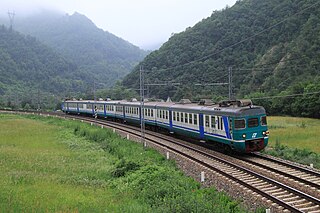
The ALe 801/940 are a series of EMUs built in the 1970s for the Italian state railway FS, now used by its successor, Trenitalia.
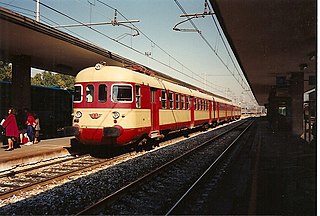
The ALe 803 are a series of EMUs built in the 1960s for the Italian state railways FS, and now used by the railway company Trenitalia.

The EN 300 are a series of EMUs built in 1977 for the Italian railway company SEPSA, used on the commuter railways Circumflegrea and Cumana.
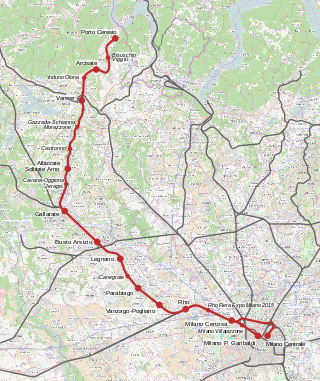
Porto Ceresio–Milan railway is a railway line in Lombardy, Italy. It uses the tracks of the Milan–Arona railway until Gallarate.

The Bologna–Ancona railway is an Italian railway that connects the city of Bologna with the city of Ancona, passing through the Po Valley to Rimini and along the Adriatic coast for the rest of the line.

The ALe 582 is an Italian electric multiple unit train designed for commuter and medium-distance services, developed in the mid-1980s to replace pre-war and immediately post-war EMUs and locomotive-hauled trains on various lines in Sicily and Southern Italy, although they later diffused on the whole FS network. They're part of the "ALe Elettroniche" or "G.A.I." family, together with their predecessors ALe 724 and their successors, the ALe 642.

The Ferrovie dello Stato Class 685 is a class of 2-6-2 'Prairie' express train steam locomotives. These are colloquially known as Regine, mirroring their fame as one of the most successful and appreciated Italian steam locomotives.

The Ferrovie dello Stato Italiane Class 940 is a 2-8-2 steam tank locomotive, derived from the Class 740 tender locomotive.

The Ferrovie dello Stato Italiane Class 680 is a 2-6-2 express steam locomotive; it was the direct ancestor of the very successful and appreciated Class 685.

The FS Class E.431 was a class of three-phase AC electric locomotives of the Italian State Railways (FS).
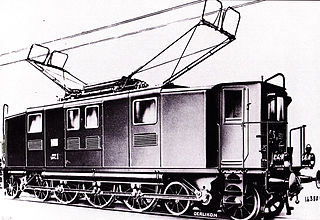
FS Class E.332 was a class of three-phase electric locomotives of the Italian State Railways (FS). They were used for the haulage of passenger trains between 1917 and 1963. Designed and built at the same time as the FS Class E.331, they represented an attempt by FS to extend the use of three-phase AC electric traction from primary to secondary routes. Their performance was disappointing and they were relegated to a marginal role, in which they remained despite several modifications.

FS Class E.333 was a class of electric locomotives of the Ferrovie dello Stato (FS), powered by three-phase alternating current, which were in service from 1923 to 1968. They were designed by Kálmán Kandó for hauling fast passenger trains. Having the same electrical equipment as the FS Class E.552 locomotives, they presented the same defects and had to be modified. After modification, they were able to carry out the services for which they were designed.
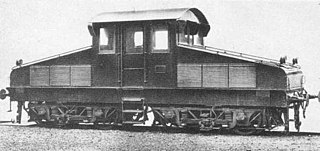
FS class E.420 locomotive was a third rail electric locomotive built for the operation of the Milan - Gallarate - Varese railway in Italy.





















